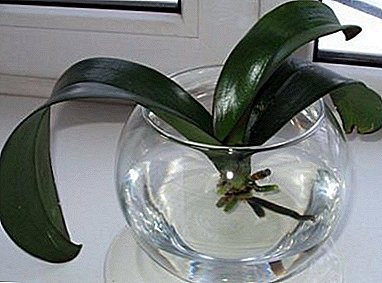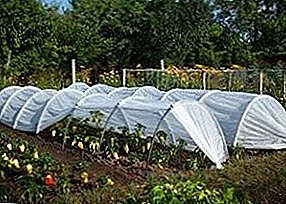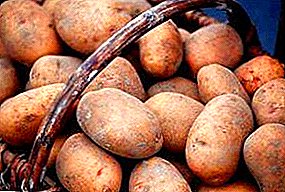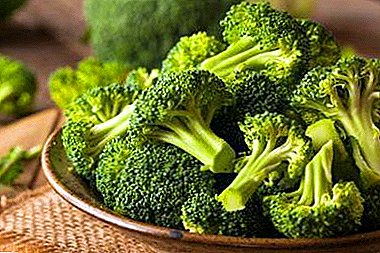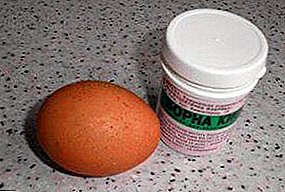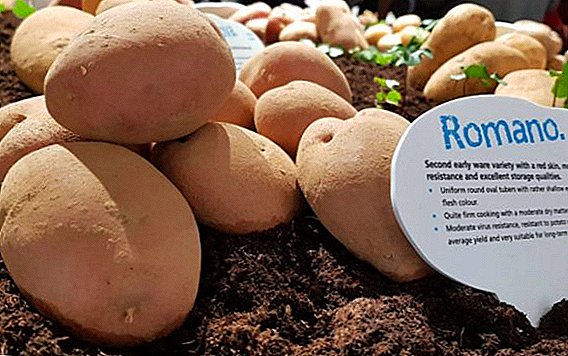 Potatoes are good in all forms: fried, boiled, stewed, baked, as a mashed potatoes, chips and french fries. But, depending on the variety, it is especially good. For example, potatoes "Romano" in one voice praise both culinary specialists, and vegetable growers, transport workers, and sellers, having every reason to do so.
Potatoes are good in all forms: fried, boiled, stewed, baked, as a mashed potatoes, chips and french fries. But, depending on the variety, it is especially good. For example, potatoes "Romano" in one voice praise both culinary specialists, and vegetable growers, transport workers, and sellers, having every reason to do so.
Breeding history
 This successful potato variety was bred by Dutch vegetable growers at the end of the last century. He quickly gained popularity not only in his homeland and in neighboring countries, but also in Eastern Europe, where he perfectly caught on in almost all its corners.
This successful potato variety was bred by Dutch vegetable growers at the end of the last century. He quickly gained popularity not only in his homeland and in neighboring countries, but also in Eastern Europe, where he perfectly caught on in almost all its corners.
Moreover, when at the beginning of this century, breeders literally flooded the vegetable market with new promising potato varieties, already in the status of veteran Romano did not succumb to the pressure of competitors, did not get lost among them, but, on the contrary, strengthened their position as one of the best potato varieties.
The fruit of the Dutch breeders "Agrico" are also varieties "Riviera" and "Aladdin".
Description of tubers
"Romanov" potatoes can be easily distinguished by their smooth peel pink, rare and shallow eyes and oval-round shape. Among the tubers, the average weight of which is 95 g, there are practically no small ones.
Under a rather coarse peel, the flesh is found, the color of which is described by some as light cream, and others as creamy. But with regard to taste, there is no disagreement: on a ten-point taste scale, the Romano tuber crops get the maximum ten points.  From the tubers of this potato containing up to 17 percent starch and about 19 percent dry matter, it turns out a great mashed potatoes. According to culinary evidence, this variety is almost ideal for frying, stewing, baking, for cooking french fries and making chips.
From the tubers of this potato containing up to 17 percent starch and about 19 percent dry matter, it turns out a great mashed potatoes. According to culinary evidence, this variety is almost ideal for frying, stewing, baking, for cooking french fries and making chips.
I am delighted with the appearance of the tubers "Romano" and representatives of trade. Commercial type potato is estimated at 96 percent.
Did you know? Globally, potatoes are quoted as the main food crop, with the exception of grains. In the overall standings, potatoes allow only wheat, rice and corn forward..
Characteristic variety
In addition to the undoubtedly high taste qualities, the potato variety "Romano" is also distinguished by high yields, rather early ripening periods and resistance to diseases.
Resistance to diseases and pests
Possessing good immunity, this potato has an enviable ability to resist most potato diseases and pests. For example, "Romano" practically not afraid:
- late blight, with regard to tubers, and slightly less resistant to leaves;
- viral diseases;
- scab;
- Colorado potato beetle;
- mosaic diseases;
- rhizoctoniosis.
The only pest against which this variety has no immunity, is golden potato nematode. 
Precocity
This potato variety is listed in the category medium early table varieties. It ripens in a maximum of three months. And by this time he practically does not have small tubers.
Medium early ripening varieties include Adretta, Sante, Ilinsky, Rodrigo, Colombo, Courage, and Black Prince.
Yield
One of the most attractive for vegetable growers sides of the variety is its independence from the growing region and weather conditions. Everywhere and always he gives a stable harvest. On average, each bush of this potato produces up to 800 grams of tuber crops, which is 600 quintals per hectare.
Did you know? The fantastic ability of potatoes to combine with different foods and the variety of ways of processing allow using it to cook over two thousand dishes, among which there are even desserts.
Growing regions
This variety grows well in all European regionsbesides the Far North, as well as in the Far East. One of the valuable qualities of the Romano potato is its ability to grow safely in regions where dry periods are possible. At the same time, the "Romanov" potatoes are very sensitive to frost. 
Landing rules
Although this potato variety produces a stable crop, regardless of climatic zones and weather conditions, each gardener is interested in a stable high yield. But for this you should make some effort.
Optimal timing
Planting potato tubers in the ground should not be until the danger of frost. The optimum temperature for planting tubers in the soil is in the range between 15 ° C and 20 ° C. It is clear that in different regions these conditions are created at different times.
When determining the time for planting potatoes, some gardeners are guided by the lunar calendar.
Location selection
To achieve a good harvest, you need to choose the optimal place for its growth. This place must meet the following criteria:
- for growing potatoes, open and sufficiently sunlit areas are chosen;
- lowland plants, wet and flooded areas are contraindicated;
- optimal for planting places located on the southern or south-western gentle slopes;
- good results can be achieved by planting potatoes on treated virgin soil.

Good and bad predecessors
Particular attention when planting this vegetable should pay attention to what predecessors were on the ground, intended for potato plantings.
It will be great to grow potatoes on the soil that was planted before:
- wheat;
- oats;
- Vicia;
- beetroot
- carrots;
- cucumbers;
- cabbage;
- greens;
- flax;
- leguminous crops;
- lupine.
 But extremely undesirable plant potatoes on the soil where they were previously growing:
But extremely undesirable plant potatoes on the soil where they were previously growing:
- tomatoes;
- eggplants;
- pepper.
It is also not recommended to grow this crop for two or more years at the same place.
Soil preparation
On the open and sunny plot chosen for the potato, there should be soil that contributes to the maximum yield. Since this culture does not like waterlogged soil, if the groundwater in the area lies close to the surface, it is necessary to plant tubers on ridges or ridges.
Too acidic soil should be refined with lime or dolomite flour.
Learn how to independently determine the acidity of the soil on the site and deoxidize the soil.
Loamy and heavy clay soil can be brought to the required condition by adding humus or peat in the amount of one bucket per square meter. The same humus and peat are added to the sandy and sandy soils with the addition of clay soil.  It is also useful to feed the soil with mineral fertilizers in the form of a mixture of two tablespoons of superphosphate, a tablespoon of potassium sulfate and a glass of wood ash.
It is also useful to feed the soil with mineral fertilizers in the form of a mixture of two tablespoons of superphosphate, a tablespoon of potassium sulfate and a glass of wood ash.
In addition, in the area intended for potatoes, should be carried out such operations:
- Since the potato has a tendency to loose, air-saturated soil, they dig up a plot in the autumn, not leveling it with a rake or a harrow. For drainage along the beds, grooves are dug through which thawed and rainwater will flow.
- In conditions of heavy loamy soils, it is useful to separate them in the fall through ridges that contribute to the rapid drying of the soil in the spring.
- In spring, the soil must be re-digged and crushed with a harrow. When planting tubers, special attention should be paid to the moisture of the earth, which is undesirable in both overmoistened and overdried conditions.
Preparation of planting material
High-quality tubers for planting also affect the future harvest.  To planting material acquired the necessary condition, you must:
To planting material acquired the necessary condition, you must:
- Three weeks before planting, the tubers prepared for this must be taken out to a warm, dry and bright place, which is inaccessible, however, for direct sunlight.
- The temperature of the ambient air should not be below + 18 ° C.
- In order to avoid drying the tubers should be periodically sprayed with water.
- To prevent fungal and other diseases, planting material is useful to process fungicides.
- The use of ash is very useful for increasing yields. To do this, wet potatoes need to sprinkle with wood ash.
Scheme and depth of landing
As a rule, potatoes are planted and grown in rows. The early ripening varieties to which Romano also belongs are usually planted with a half-meter distance between rows and a distance of 25-35 centimeters between the holes.
There are also three ways of landing in the form:
- smooth;
- trench;
- ridge.
If the area of land intended for growing vegetables is flat, well illuminated by the sun and without stagnant water, then the planting consists in digging holes one-half shovels in the depth and burrowing the tubers after placing them in the holes.  In hot climates, on sandy and sandy soils that retain moisture poorly, it is recommended to plant potatoes in shallow trenches from 5 to 10 centimeters, which in the autumn it is useful to fertilize with humus, peat and sawdust.
In hot climates, on sandy and sandy soils that retain moisture poorly, it is recommended to plant potatoes in shallow trenches from 5 to 10 centimeters, which in the autumn it is useful to fertilize with humus, peat and sawdust.
Important! In no case can this method be used on moist and dense grounds, the stagnation of water in which will ruin the potato.
But on waterlogged heavy soils with high groundwater levels, the opposite is true. Here combs should be arranged with a height of 15-30 centimeters and a distance of at least 70 centimeters between them. This method is guaranteed to protect the tubers from waterlogging. 
How to care
Potato varieties "Romano" excessive efforts in self-care does not require. It is quite unpretentious and resistant to diseases, however, some features in its cultivation have to be taken into account.
Watering
This variety tolerates dry weather, but this does not mean that it is comfortable without water. Like any potato, it prefers a moderately moist soil. This is especially true during the formation of tubers, starting simultaneously with the formation of buds and flowering.
Important! In general, the general rule is that the soil moisture under the potatoes should be about 80 percent of its full capacity.
In moderate climatic conditions, in the presence of regular rains, additional potato bushes are not required. But when the weather is sultry and devoid of rain, it takes two to three times a day to water.

Top dressing
During the growing season of the potato bush spend three dressings.
AT first time this occurs during the growth of green mass. However, it is required only if the tops are poorly developed, the leaves have a yellowish tinge, and the stems are too thin. Then it should be dissolved in a bucket of water in a teaspoon of urea and universal vegetable fertilizer. This solution should be made in the amount of half a liter under each bush on a moist soil.
When flower buds begin to form, should be held second feeding, for which of a bucket of water, a glass of wood ash and a tablespoon of potassium sulfate, you need to make a mixture that stimulates flowering.
And with the help the third feed accelerate the formation of tubers. In the midst of flowering is a mixture of a bucket of water and tablespoons of universal vegetable fertilizers and superphosphate, which in the amount of half a liter is made under each plant.
Learn more about feeding potatoes.
Weeding and loosening the soil
Not later than a week after the start of active shoots on the beds it is necessary to lead the first interrow loosening and harrowing. The following weeding and loosening the soil should be carried out based on the number of weeds, soil conditions and weather. This is usually done at least three times per season. 
Hilling
Hilling, stimulating the growth of plants, flowering and the formation of tubers, should be carried out every two weeks to a height of 6 centimeters.
Harvesting and storage
The first potato tubers of the "Romano" variety are dug out at the end of June, and the bulk of the harvest comes at the beginning of September. Dug up tubers must be dried for three to five days either in the sun or on rainy days - under a canopy.
Before harvesting the vegetable for storage, it is necessary to select the best tubers as seed material for the next season.
The variety "Romana" is remarkable for its excellent tuber keeping capacity, due to which it is able to be stored in a dark and cool place for a very long time with almost no losses. A thick skin of potatoes contributes to painless transportation of them over long distances. 
Advantages and disadvantages
Among the many merits Romano potatoes usually focus on:
- great taste;
- decent presentation;
- possibilities of long-term transportation with a minimum of losses;
- sustainable yield;
- resistance to diseases and pests;
- varietal resistance to soil moisture deficiency;
- lossless storage time;
- responsiveness to feedings.
BUT deficiencies this variety is very small. These include:
- susceptibility to frost;
- thick rind, which is a plus when transporting, but for some it looks like a drawback when cooking tubers;
- inability to resist the golden potato nematode.
Reviews of potatoes "Romano"


The potato variety "Romano" in tough competition with numerous new varieties of this vegetable successfully survived and maintained its position on the farmers' fields and personal plots, delighting consumers with its great taste.


